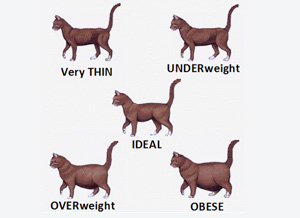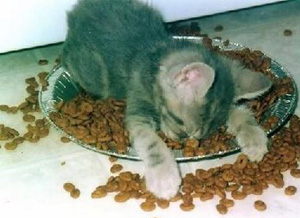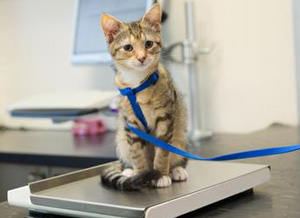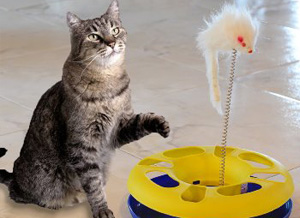Cat Healthy Body Type
 There are more overweight cats now than ever before. Pet obesity in general (dogs and cats) is at an all time high. Cats are designed to be hunters out looking for prey and working for their meals. These days more cats are kept indoors, and deprived of the exercise they would have outside chasing bugs and birds, climbing trees and running from dogs, and generally wandering about and amusing themselves. Add to this the fact that many cat owners free feed their pets, and it’s no wonder that obese cats are easy to find. There should not be an expectation of accepted weight gain after neutering or spaying. You have to keep an eye on your pet’s body condition and be ready to modify the eating habits if he seems to be gaining or losing weight. Fortunately, a few easy modifications and some extra time can make a big difference towards returning your cat to a healthy weight.
There are more overweight cats now than ever before. Pet obesity in general (dogs and cats) is at an all time high. Cats are designed to be hunters out looking for prey and working for their meals. These days more cats are kept indoors, and deprived of the exercise they would have outside chasing bugs and birds, climbing trees and running from dogs, and generally wandering about and amusing themselves. Add to this the fact that many cat owners free feed their pets, and it’s no wonder that obese cats are easy to find. There should not be an expectation of accepted weight gain after neutering or spaying. You have to keep an eye on your pet’s body condition and be ready to modify the eating habits if he seems to be gaining or losing weight. Fortunately, a few easy modifications and some extra time can make a big difference towards returning your cat to a healthy weight.
First off, we need to decide if your cat is at a healthy weight or not. You should be able to feel the ribs easily. When looking at your cat from above you should be able to see a waist behind the rib cage. There should be no hanging belly. If he jumps off the sofa and it sounds like a Bible hit the floor, well… it might be time to hit the cat gym!
Cat Diet
 The cat’s diet is the second thing to evaluate. Be sure you are feeding a good quality nutritionally complete feed. Cats are carnivores. Meat or seafood should be the first ingredient listed. A vegetarian diet is not appropriate. How many calories are in a portion of the food? A good place to start is to add up the calories you feed your cat on a daily basis. If the food container does not have the information, there are several websites that list nutritional information for many pet foods. Catinfo.org has a large list, and there is a wide range of calories in feeds. Do not forget to add the calories of the treats and snacks you (and all family members) give him every day. Does he steal food from the dog? Does the fat cat steal from another cat? Does he get table scraps? You must have an idea of the daily calories consumed, so that a reasonable decrease can be made in a healthy manner. A cat losing weight too rapidly can result in severe liver disease in an obese cat. The cat did not get fat overnight, so be patient with weight loss goals.
The cat’s diet is the second thing to evaluate. Be sure you are feeding a good quality nutritionally complete feed. Cats are carnivores. Meat or seafood should be the first ingredient listed. A vegetarian diet is not appropriate. How many calories are in a portion of the food? A good place to start is to add up the calories you feed your cat on a daily basis. If the food container does not have the information, there are several websites that list nutritional information for many pet foods. Catinfo.org has a large list, and there is a wide range of calories in feeds. Do not forget to add the calories of the treats and snacks you (and all family members) give him every day. Does he steal food from the dog? Does the fat cat steal from another cat? Does he get table scraps? You must have an idea of the daily calories consumed, so that a reasonable decrease can be made in a healthy manner. A cat losing weight too rapidly can result in severe liver disease in an obese cat. The cat did not get fat overnight, so be patient with weight loss goals.
Cat Weight
 The third fact we need to know is how many calories are needed to maintain the cat’s present weight. We have to weigh the cat. The easiest way is to weigh yourself, then weigh yourself holding the cat. A quick math calculation shows the calories needed daily to maintain the present weight: the cat’s body weight in kilograms X 30. Add 70. Multiply by .8. Lets say you have a 25# cat; it takes 328 calories to maintain that weight. If we feed less than that, he will lose weight, which is the goal. Compare this number to the total calories he consumes daily from the previous paragraph.
The third fact we need to know is how many calories are needed to maintain the cat’s present weight. We have to weigh the cat. The easiest way is to weigh yourself, then weigh yourself holding the cat. A quick math calculation shows the calories needed daily to maintain the present weight: the cat’s body weight in kilograms X 30. Add 70. Multiply by .8. Lets say you have a 25# cat; it takes 328 calories to maintain that weight. If we feed less than that, he will lose weight, which is the goal. Compare this number to the total calories he consumes daily from the previous paragraph.
Cat Exercise
 We or your veterinarian can help you with food and treat selections and a proper feeding schedule. I was serious about the cat gym… sort of. Cat exercise equipment is simple: toys that he likes to chase, laser pointers, feathery things on sticks and strings. Cat training is possible, it just takes time. They can be taught to walk on a leash or harness for exercise. They can learn to play ball. They can be lured up and down stairs. There are many climbing toys on the market. A secure outdoor run can be made so he walks around more watching the world. Make time for daily play sessions to burn calories.
We or your veterinarian can help you with food and treat selections and a proper feeding schedule. I was serious about the cat gym… sort of. Cat exercise equipment is simple: toys that he likes to chase, laser pointers, feathery things on sticks and strings. Cat training is possible, it just takes time. They can be taught to walk on a leash or harness for exercise. They can learn to play ball. They can be lured up and down stairs. There are many climbing toys on the market. A secure outdoor run can be made so he walks around more watching the world. Make time for daily play sessions to burn calories.
An obese cat is at risk for heart disease, diabetes, degenerative joint disease, and liver disease to mention a few. Make time to help your pet lose weight and regain his health. He will live longer and be a happier and healthier companion for many years to come.

Recent Comments